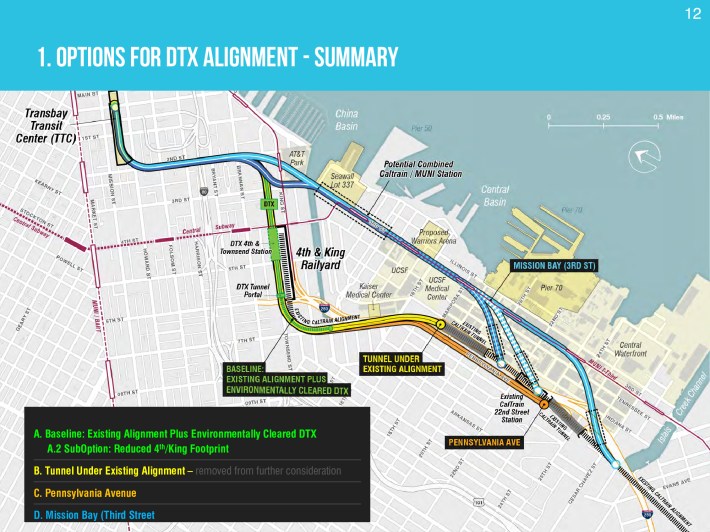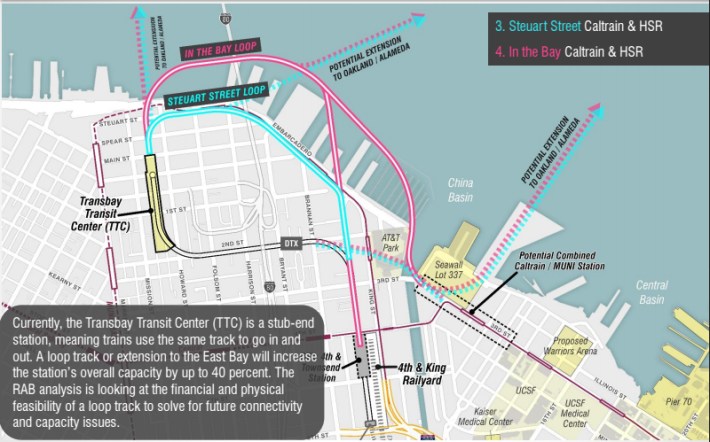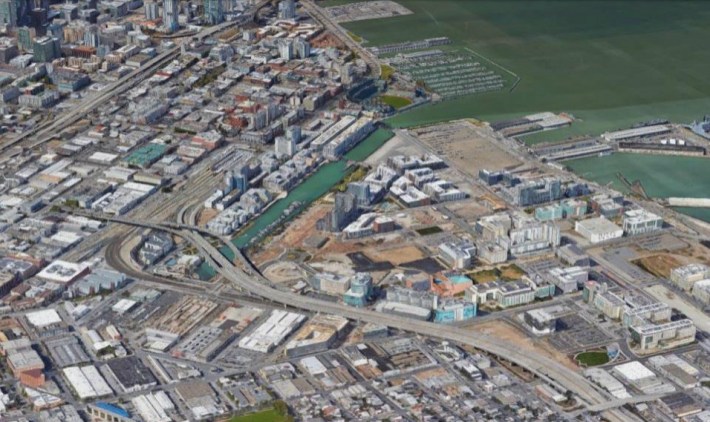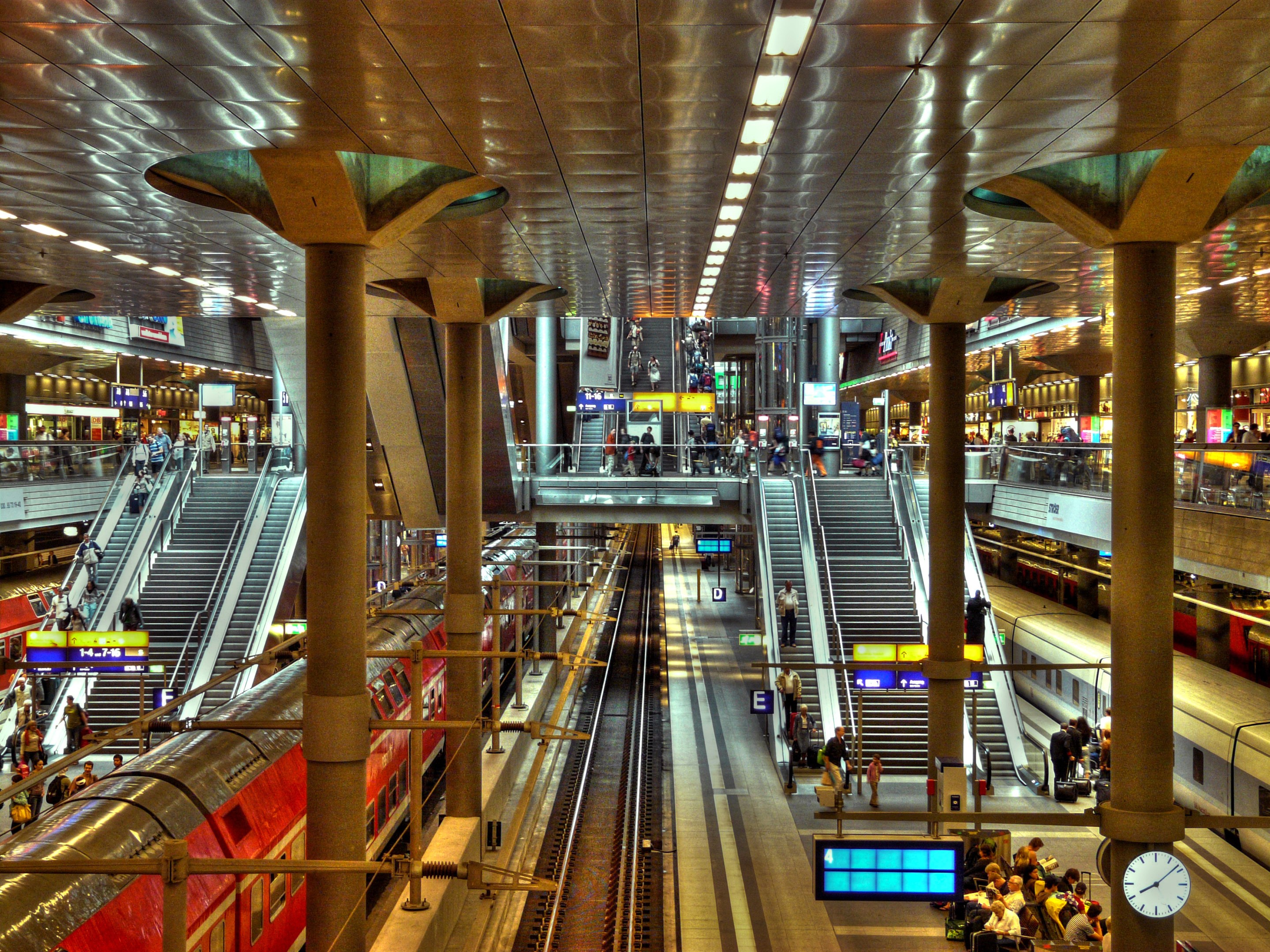The San Francisco Planning Department will be presenting the San Francisco Board of Supervisors with updated plans for getting trains from the Caltrain corridor into the lower level of the Transbay Transit Center. The department has narrowed the choices down to three different options: maintaining the existing Caltrain alignment to Fourth and King and connecting to the originally planned Downtown Extension (DTX) to get to Transbay, shifting part of the alignment under Pennsylvania Avenue, or tunneling under Third Street out through Mission Bay.
The San Francisco Transit Riders got a chance to chime in on the various options, dubbed the Railyard Alternatives & I-280 Boulevard Feasibility Study (RAB) at a presentation earlier this week given by Susan Gygi, an engineer with the Planning Department.

As Streetsblog readers know, the Transbay Transit Center train box, located in the bowels of the building, is designed to one day become the "Grand Central Station of the West," with high-speed rail and an electrified Caltrain terminating there. However, the $4 billion needed to construct the train tunnel to bring Peninsula rail service from Fourth and King to the new station has not materialized. Some critics have accused City Hall of failing to champion the project. The latest threat to the project was the Trump Administration's near-cancellation of federal funding for Caltrain electrification, which may have already caused some further delay in plans for the tunnel.
Meanwhile, the SF Planning department has been busy putting together a study of alternate alignments. The DTX, as originally conceived, dipped the trains underground at Fourth and King and then followed a winding path under Townsend, before turning left down Second and then right into the terminal.
According to Gygi the original DTX alignment always presented a problem farther to the south, because of the at-grade portion of the alignment below I-280. With the train frequencies envisioned between HSR and Caltrain, at about a train every three minutes during rush hour, the gates would constantly be going up and down, effectively cutting off UCSF Medical Center. But grade separating it would result in some pretty terrible streetscapes, such as this rendering below:

That's why, ostensibly at least, Planning is proposing alignments that would jog the tracks over to Third in a tunnel and then bore a tunnel to Second Street. Gygi said that because of the utility relocation work that was done to clear the way for the T-Third line, there's a clear shot for tunneling. Some critics, however, have dismissed this new alignment as a needless effort to get another station built to help the development of Mission Bay. Under all scenarios, the city would abandon and redevelop at least some of the footprint currently taken up by Caltrain for train storage. And tearing down part of I-280 could also be part of a whole redevelopment project for the area.
Some of these scenarios have been under discussion for some time, of course. Streetsblog's perspective is simple: there are merits to both alignments, but even if the third-street alignment prevails, the city should think very, very hard before ripping out the current Caltrain tracks under I-280. Those will become incredibly important for redundancy. And the reason why will become very clear the first time a train gets stuck in a future Third Street tunnel.
Gygi also presented long-term visions for expanding the capacity of the Transbay train station, by either having a turn-around track that loops out into the bay or under Embarcadero, so trains don't have to use the same tracks to leave the station that they use to get in. That makes sense, since it would increase capacity by up to forty percent--it would certainly be a great asset in conjunction with a new Transbay crossing that would make it possible for trains to continue on to Alameda and Oakland.
These plans, as Gygi explained, are part of a 100-year vision. Fair enough, but let's just hope it doesn't take that long before any of it actually gets built.
Meanwhile, the alignment decision is supposed to be voted on by the SF Board of Supervisors by December 2017, according to Gina Simi, Communications Manager for the Planning Department.
What do you think of the various alternatives? Would you rather the city stick with the original DTX alignment? Or do you think the Mission Bay options will be better for the city in the long run? Post below.








